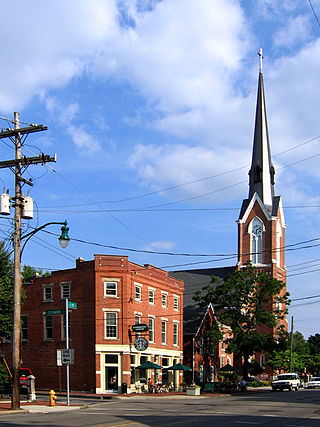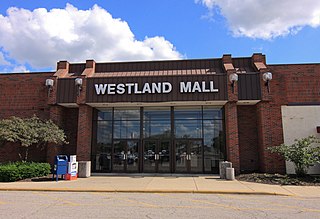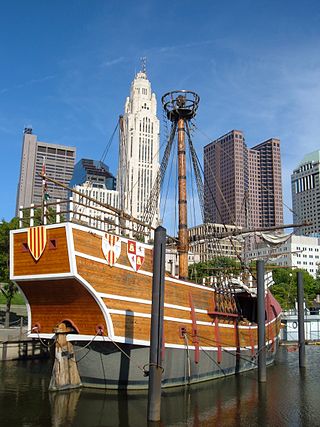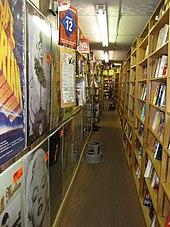
Columbus is the capital and most populous city of the U.S. state of Ohio. With a 2020 census population of 905,748, it is the 14th-most populous city in the U.S., the second-most populous city in the Midwest after Chicago, and the third-most populous U.S. state capital after Phoenix, Arizona and Austin, Texas. Columbus is the county seat of Franklin County; it also extends into Delaware and Fairfield counties. It is the core city of the Columbus metropolitan area, which encompasses ten counties in central Ohio. It had a population of 2,138,926 in 2020, making it the largest metropolitan area entirely in Ohio and 14th-largest city in the U.S.

City Lights is an independent bookstore-publisher combination in San Francisco, California, that specializes in world literature, the arts, and progressive politics. It also houses the nonprofit City Lights Foundation, which publishes selected titles related to San Francisco culture. It was founded in 1953 by poet Lawrence Ferlinghetti and Peter D. Martin. Both the store and the publishers became widely known following the obscenity trial of Ferlinghetti for publishing Allen Ginsberg's influential collection Howl and Other Poems. Nancy Peters started working there in 1971 and retired as executive director in 2007. In 2001, City Lights was made an official historic landmark. City Lights is located at 261 Columbus Avenue. While formally located in Chinatown, it self-identifies as part of immediately adjacent North Beach.


German Village is a historic neighborhood in Columbus, Ohio, just south of the city's downtown. It was settled in the early-to-mid-19th century by a large number of German immigrants, who at one time comprised as much as a third of the city's entire population. It became a city historic district in 1960 and was added to the National Register of Historic Places in 1974, becoming the list's largest privately funded preservation district, and in 2007, was made a Preserve America Community by the federal government. In 1980, its boundaries increased, and today it is one of the world's premier historic restorations.

Columbus City Center was a 1,250,000 sq ft (116,000 m2), three-level shopping mall in Columbus, Ohio. It was located in the city's downtown, near the Ohio Statehouse, next to the Ohio Theatre, and connected to a Hyatt hotel. The mall had a large parking structure attached that, despite the mall's closure in 2009, is still used extensively by downtown workers. The parking structure has been joined, directly or via bridge respectively, to two 12 story structures, 250 S. High Street and 80 on the Commons, both of which feature lower level office spaces with residential spaces on the upper floors.
Beechcroft High School is a four-year high school located on the north side of Columbus, Ohio. It is a part of Columbus City Schools. Beechcroft was first opened in 1976 as a six-year junior/senior high school. At that time, school enrollment peaked at 1,200+ students. Current enrollment is 950 students.

Westland Mall is a defunct 860,000-square-foot (80,000 m2) shopping center located at the intersection of U.S. Route 40 and Interstate 270 on the west side of Columbus, Ohio. In November 2012, the majority of the mall closed, and the last anchor closed in 2017. Developers plan to demolish the structure and build a mixed-use project at the site.

The Mall at Tuttle Crossing is an enclosed shopping mall located in northwest Columbus, Ohio. It has a Dublin, Ohio mailing address, but it is in the Columbus city limits. It was developed by a joint venture of Taubman Centers and the Georgetown Company and opened on July 24, 1997. In 2021, the mall was reported to be heading towards foreclosure. The anchor stores are Macy's, Scene75 Entertainment Center, and JCPenney. There is one vacant store that was once Sears.

Germain Amphitheater was a 20,000-seat outdoor entertainment venue located in Columbus, Ohio, near the suburb of Westerville. The venue opened as part of a large development venture off of Interstate Highway I-71. There were 6,700 seats in an open-air pavilion—much of it under cover—and room for another 13,300 people on general admission lawn seating. The concert season began mid-May, continuing through early October and featured 20-30 concerts per year. At the time it opened, it was the largest and most suitable venue for concerts in central Ohio.

The Gotham Book Mart was a famous Midtown Manhattan bookstore and cultural landmark that operated from 1920 to 2007. The business was located first in a small basement space on West 45th Street near the Theater District, then moved to 51 West 47th Street, then spent many years at 41 West 47th Street within the Diamond District in Manhattan, New York City, before finally moving to 16 East 46th Street. Beyond merely selling books, the store virtually played as a literary salon, hosting meetings of the Finnegans Wake Society, the James Joyce Society, poetry and author readings, art exhibits, and more. It was known for its distinctive sign above the door which read, "Wise Men Fish Here". The store specialized in poetry, literature, books about theater, art, music and dance. It sold both new books as well as out-of-print and rare books.

Thalia is a chain of more than 200 book shops in Germany, Austria, and Switzerland.

The Ohio History Center is a history museum and research center in Columbus, Ohio. It is the primary museum for Ohio's history, and is the headquarters, offices, and library of the Ohio History Connection. The building also houses Ohio's state archives, also managed by the Ohio History Connection. The museum is located at the Ohio State Fairgrounds, site of the Ohio State Fair, and a short distance north of downtown. The history center opened in 1970 as the Ohio Historical Center, moving the museum from its former site by the Ohio State University. The building was designed by Ireland & Associates in the Brutalist style. It was listed on the National Register of Historic Places along with the Ohio Village in 2023.
Kingsdale Shopping Center, also known as Kingsdale, Kingsdale Center, and Kingsdale Mall, is a large, mixed-use shopping center in Upper Arlington, Ohio, a suburb of Columbus. It features a Giant Eagle Market District supermarket.

Hanif Abdurraqib is an American poet, essayist, and cultural critic. He is the author of 2016 poetry collection The Crown Ain't Worth Much, the 2017 essay collection They Can't Kill Us Until They Kill Us, the 2019 non-fiction book, Go Ahead in the Rain: Notes on A Tribe Called Quest on the American hip-hop group A Tribe Called Quest, the 2019 poetry collection A Fortune for Your Disaster, and the 2021 essay collection A Little Devil in America: Notes in Praise of Black Performance which received the 2022 Andrew Carnegie Medal for Excellence. Go Ahead in the Rain was on the long list for the 2019 National Book Award.

The Toledo and Ohio Central Railroad Station, today named Station 67, is a union meeting space and event hall located in Franklinton, near Downtown Columbus, Ohio. Built by the Toledo and Ohio Central Railroad from 1895 to 1896, it served as a passenger station until 1930. It served as an office and shelter for Volunteers of America from 1931 to 2003, and has been the headquarters of International Association of Fire Fighters Local 67, a firefighters' union, since 2007. The building was placed on the National Register of Historic Places in 1973. During its history, the building has experienced fires and floods, though its relatively few owners have each made repairs and renovations to preserve the building's integrity. The building is the last remaining train station in Columbus.

The Main Library of the Columbus Metropolitan Library (CML) system is located in Downtown Columbus, Ohio, United States. The public library is the largest in the library system and holds approximately 300,000 volumes. It includes numerous rooms, including separate spaces for children, teens, an adult reading room, newspaper room, auditorium, gallery, gift shop, and a cafe. The third floor includes a computer lab and houses the Franklin County Genealogical & Historical Society.
The Columbus Register of Historic Properties is a register for historic buildings and other sites in Columbus, Ohio, United States. The register is maintained by the City of Columbus Historic Resources Commission and Historic Preservation Office, and was established in 1980. Many of these landmarks are also listed on the National Register of Historic Places, providing federal tax support for preservation, and some are further designated National Historic Landmarks, providing additional federal oversight.

The Santa Maria Ship & Museum was a museum ship in downtown Columbus, Ohio. The craft was a full-size replica of the Santa María, one of three ships Christopher Columbus used in 1492 during his first voyage to the Americas. The ship was displayed in Columbus from 1991 to 2014, when it had to be relocated due to the Scioto Mile project reshaping the riverbanks. The Santa Maria has sat on a city-owned lot since its relocation.

The 1887 Franklin County Courthouse was the second permanent courthouse of Franklin County, Ohio. The building, located in the county seat of Columbus, stood from 1887 to 1974. It replaced a smaller courthouse on the site, extant from 1840 to c. 1884. The 1887 courthouse deteriorated over several decades, and the site was eventually replaced with Dorrian Commons Park, open from 1976 to 2018; the court moved to a new building nearby. As of 2020, the site is planned to once again hold the county's Municipal Court building.



















